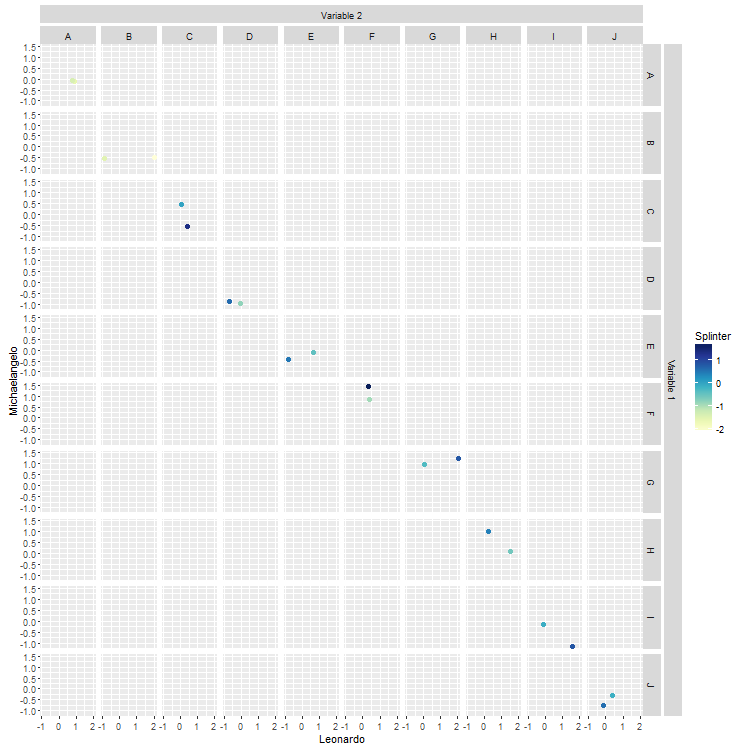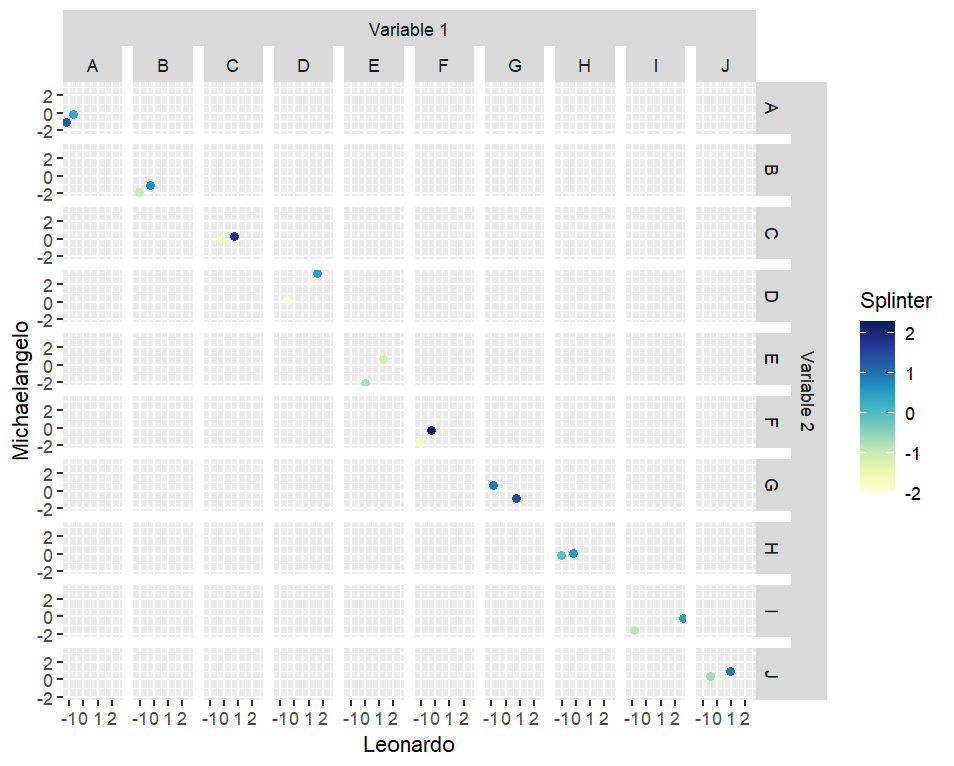Here is some minimal code to generate a graph with two sets of facets.
library("ggplot2", quietly = TRUE, warn.conflicts = FALSE)
library("RColorBrewer", quietly = TRUE, warn.conflicts = FALSE)
val.a <- rnorm(10)
val.b <- rnorm(10)
val.c <- c("A","B","A","A","B","B","B","B","A","B")
val.d <- c("D","D","E","D","E","E","E","D","D","E")
val.e <- rnorm(10)
maya <- data.frame(val.a,val.b,val.c,val.d,val.e)
ggplot(maya, aes(x=val.a, y=val.b)) +
geom_point(shape=20,size=3, aes(colour=val.e)) +
facet_grid(val.c~val.d) +
xlab("Leonardo") + ylab("Michaelangelo") +
scale_colour_gradientn(colours=brewer.pal(9,"YlGnBu"), name="Splinter")
I can't figure out how to add an overall facet label so that the names Donatello and Raphael are on the top and right hand side axis.
I saw some similar solutions on SO, but I can't make heads or tails of the code. Please would you suggest an answer to my conundrum?
Similar question here, but it fails for me if I have more than two facets. The labels show up somewhere inside the graph. Is there a way to make this work for the general case?
So I tried rawr's solution at the link above, and it ended up at the same place for multiple columns. Here's the code updated to rawr's solution, but it's producing the labels in unexpected (for me because I don't understand the solution) places.
library("ggplot2", quietly = TRUE, warn.conflicts = FALSE)
library("RColorBrewer", quietly = TRUE, warn.conflicts = FALSE)
val.a <- rnorm(20)
val.b <- rnorm(20)
val.c <- c("A","B","C","D","E","F","G","H","I","J")
val.d <- c("A","B","C","D","E","F","G","H","I","J")
val.e <- rnorm(20)
maya <- data.frame(val.a,val.b,val.c,val.d,val.e)
p <- ggplot(maya, aes(x=val.a, y=val.b)) + geom_point(shape=20,size=3, aes(colour=val.e)) + facet_grid(val.c~val.d) + xlab("Leonardo") + ylab("Michaelangelo") + scale_colour_gradientn(colours=brewer.pal(9,"YlGnBu"), name="Splinter")
z <- ggplotGrob(p)
library(grid)
library(gtable)
# add label for right strip
z <- gtable_add_cols(z, unit(z$width[[7]], 'cm'), 7)
z <- gtable_add_grob(z,
list(rectGrob(gp = gpar(col = NA, fill = gray(0.5))),
textGrob("Variable 1", rot = -90, gp = gpar(col = gray(1)))),
4, 8, 6, name = paste(runif(2)))
# add label for top strip
z <- gtable_add_rows(z, unit(z$heights[[3]], 'cm'), 2)
z <- gtable_add_grob(z,
list(rectGrob(gp = gpar(col = NA, fill = gray(0.5))),
textGrob("Variable 2", gp = gpar(col = gray(1)))),
3, 4, 3, 6, name = paste(runif(2)))
# add margins
z <- gtable_add_cols(z, unit(1/8, "line"), 7)
z <- gtable_add_rows(z, unit(1/8, "line"), 3)
# draw it
grid.newpage()
grid.draw(z)
Please would someone kindly point out to me the part of the code that's telling it how wide the general facet label should be?



facet_grid(val.c + "Raphael" ~ "Donatello" + val.d), but to get a single overall strip label, you're probably going to have to hack it into place by drawing rectangles, unless you can break the constraints of the facetting labellers. Also, you need to addlibrary(RColorBrewer)so the above code is reproducible. – Sideshowp <- ggplot(maya, aes(x=val.a, y=val.b)) + geom_point(shape=20,size=3, aes(colour=val.e)) + facet_grid(val.c~val.d) + xlab(NULL) + ylab(NULL) + scale_colour_gradientn(colours=brewer.pal(9,"YlGnBu"), name="Splinter") + theme(legend.position="bottom")and thengridExtra::grid.arrange(p, top = "Michaelangelo", right = "Leonardo"). – Achlamydeous